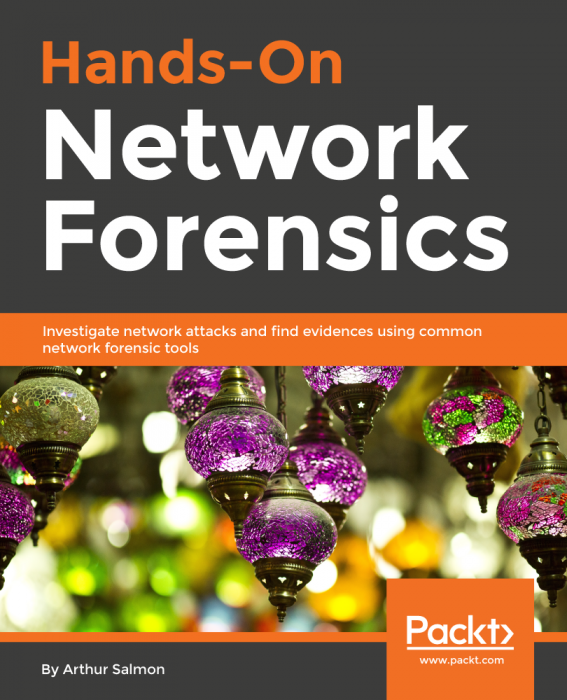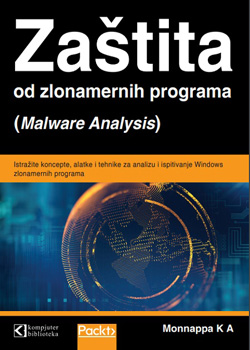
Autor: Nipun Jaswal
Broj strana: 358
ISBN broj: 9781789344523
Izdavač:
PACKT PUBLISHING ![]()
Godina izdanja: 2019.
 |
 |
 |
 |
 |
||||
Network forensics is a subset of digital forensics that deals with network attacks and their investigation. In the era of network attacks and malware threat, it’s now more important than ever to have skills to investigate network attacks and vulnerabilities. Hands-On Network Forensics starts with the core concepts within network forensics, including coding, networking, forensics tools, and methodologies for forensic investigations. You’ll then explore the tools used for network forensics, followed by understanding how to apply those tools to a PCAP file and write the accompanying report. In addition to this, you will understand how statistical flow analysis, network enumeration, tunneling and encryption, and malware detection can be used to investigate your network. Towards the end of this book, you will discover how network correlation works and how to bring all the information from different types of network devices together. By the end of this book, you will have gained hands-on experience of performing forensics analysis tasks.
Table of contents
1 Introducing Network Forensics
Technical requirements
Network forensics investigation methodology
Source of network evidence
Wireshark essentials
Exercise 1 – a noob's keylogger
Exercise 2 – two too many
Summary
Questions and exercises
Further reading
2 Technical Concepts and Acquiring Evidence
Technical requirements
The inter-networking refresher
Log-based evidence
Case study – hack attempts
Summary
Questions and exercises
Further reading
3 Deep Packet Inspection
Technical requirements
Protocol encapsulation
Analyzing packets on TCP
Analyzing packets on UDP
Analyzing packets on ICMP
Case study – ICMP Flood or something else
Summary
Questions and exercises
Further reading
4 Statistical Flow Analysis
Technical requirements
The flow record and flow-record processing systems (FRPS)
Sensor deployment types
Analyzing the flow
Summary
Questions
Further reading
5 Combatting Tunneling and Encryption
Technical requirements
Decrypting TLS using browsers
Decoding a malicious DNS tunnel
Decrypting 802.11 packets
Decoding keyboard captures
Summary
Questions and exercises
Further reading
6 Investigating Good, Known, and Ugly Malware
Technical requirements
Dissecting malware on the network
Intercepting malware for fun and profit
Behavior patterns and analysis
A real-world case study – investigating a banking Trojan on the network
Summary
Questions and exercises
Further reading
7 Investigating C2 Servers
Technical requirements
Decoding the Metasploit shell
Case study – decrypting the Metasploit Reverse HTTPS Shellcode
Analyzing Empire C2
Case study – CERT.SE's major fraud and hacking criminal case, B 8322-16
Summary
Questions and exercises
Further reading
8 Investigating and Analyzing Logs
Technical requirements
Network intrusions and footprints
A case study – defaced servers
Summary
Questions and exercises
Further reading
9 WLAN Forensics
Technical requirements
The 802.11 standard
Packet types and subtypes
Locating wireless devices
Identifying rogue access points
Identifying attacks
Case study – identifying the attacker
Summary
Questions
Further reading
10 Automated Evidence Aggregation and Analysis
Technical requirements
Automation using Python and Scapy
Automation through pyshark – Python's tshark
Merging and splitting PCAP data
Large-scale data capturing, collection, and indexing
Summary
Questions and exercises
Further reading
Budite prvi koji će ostaviti komentar.

Popust cena:
2200.00 rsd

Popust cena:
2100.00 rsd
© Sva prava pridržana, Kompjuter biblioteka, Beograd, Obalskih radnika 4a, Telefon: +381 11 252 0 272 |
||